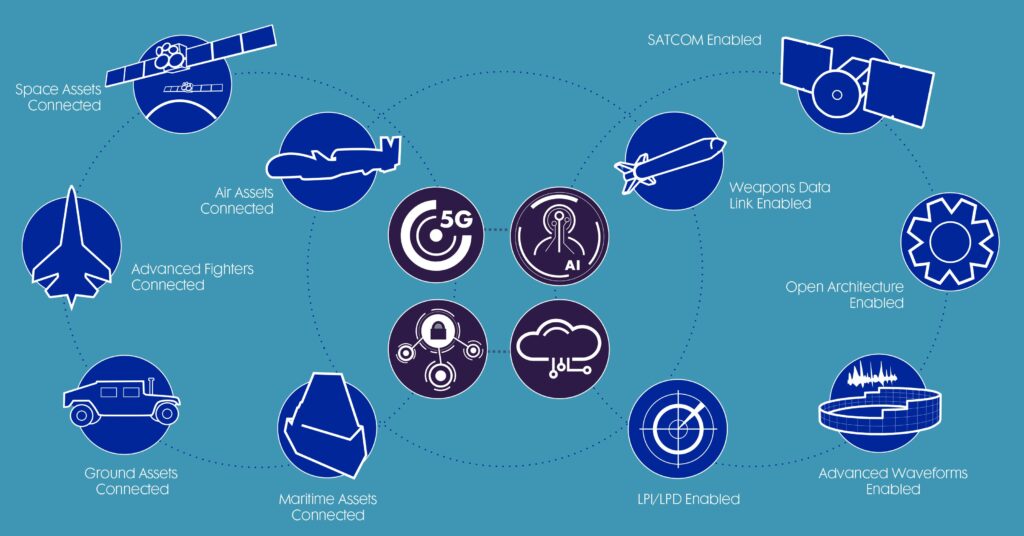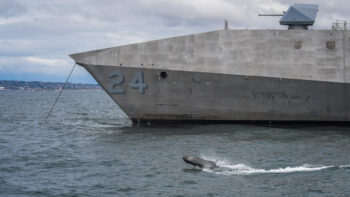
JADC2 enables what the DoD calls the “sensor-to-shooter kill chain” and what Northrop calls the Internet of Warfighting Things. (Northrop Grumman)
Correction 8/19/21 at 8:40 AM est: This story originally stated that the demonstration occurred “last week,” when in fact it occurred in June. This story has been corrected and updated.
WASHINGTON: Northrop Grumman and L3Harris Technologies in June demonstrated a new networking capability that could become integral to enabling the Pentagon’s Joint All Domain Command and Control (JADC2) and All Domain Operations concepts.
The two companies teamed up for a proof-of-concept demo in a live over-the-air test, which involved Northrop’s open architecture advanced network gateway integrated with L3’s high-capacity backbone (HCB) network capability. The companies internally funded the demo.
A gateway enables communications to traverse different networks. This is important to the JADC2 concept because the Air Force, Army, and Navy have each built and are modernizing their own discrete networks. For JADC2 to work, there must be a way to pass data — in myriad formats, at different classification levels, across a growing number of networks and nodes — from, say, a plane’s sensor on the Air Force’s network to a soldier’s communications device on the Army’s network. DoD refers to the concept as the “sensor-to-shooter kill chain.” Northrop refers to it as the Internet of Warfighting Things.
“That is, at its core, one of the most significant challenges that JADC2, [the Air Force’s] ABMS, and the other services are trying to solve,” Ian Reynolds, director of network solutions at Northrop Grumman, told Breaking Defense. “How do we quickly and efficiently connect a whole series of disparate networks, disparate platforms that have some point solutions, and how do we connect all of those, to be able to truly connect any sensor to any shooter in a multi-domain kind of way?”
The JADC2 vision is to enable services to exchange data quickly, reliably, effectively, and seamlessly between networks. Gateways are not a new technology, but last week’s exercise showed how JADC2 goals can be achieved with advanced networking capabilities under real-world circumstances using open architecture technology. The next challenge will be to scale the solution.
One JADC2 goal the exercise addressed is speed. The next-generation HCB gateway “will enable data flow 300 times faster than the speeds previously available,” Northrop claims. To achieve greater network speed, a few things are needed — increased bandwidth, via the HCB in this case, and network devices (the gateway) capable of efficiently processing higher throughput. Speed matters to success or failure in the JADC2 networked concept because of the sheer amount of data that is gathered and must be shared in a timely manner to provide accurate situational awareness and allow close coordination across land, air, sea, space, and cyber domains.
To the factors that can increase speed, Reynolds added intelligence — by which he means advanced computing capabilities pushed out to the gateway and other edge devices. In addition to increasing network bandwidth and device processing power, “We can be more intelligent about how we route that data, because although we talk about being able to get any piece of data to any shooter, not every shooter needs all the data,” Reynolds observed.
“And so, we’re looking at both angles: One, we’ve expanded the size of that pipe. But by adding more intelligent computing at the edge, as well as within the gateway and applying some AI/ML algorithms, we can also ensure that we’re only sending the needed data that is mission relevant to the individual shooter.”
Reynolds said one role of artificial intelligence/machine learning algorithms is to recognize data content, independent of the message format or the source. To illustrate the point, Reynolds provided the example of a gateway recognizing airborne data versus maritime data and making decisions about which platform to send the data to. “We’re developing machine learning algorithms to be able to do those kinds, that kind of decision making, on the fly,” he said.
The exercise also addressed the goals of effective and seamless data transfer. One of a gateway’s core capabilities is “translating” between different network protocols. Gateways, unlike most routers, use and translate between multiple protocols and types of networks. Just as a human who knows more languages can communicate with more people, so, too, gateways in networks.
The test used “the Open Mission System and Open Communications System (OMS-OCS) capabilities,” which along with open architectures allow the DoD to more easily use a greater variety of network hardware, software, and services — regardless of vendor.
The June exercise illustrated the last point. The HCB was developed in a little less than a year, and the integration and demonstration came about in a matter of weeks, Reynolds said. He attributed the quick integration to the OCS-compatibility of components and the gateway’s open architecture.
Integration can be the most complex, time-consuming, and expensive aspect of building any network or IT system, especially when it’s necessary to stitch together many proprietary, non-agnostic, closed components that aren’t designed to work smoothly together. Open architectures and open communication capabilities typically enable faster integrations.
“Having an exquisite solution is really exciting, but if it takes 10 years to bring to bear for the warfighter, and it’s limited to only a few platforms, it’s much less compelling,” Reynolds observed.
Reynolds also noted the multi-level security capabilities that are built into the gateways, acknowledging the foundational importance of cybersecurity to networks and data.






















